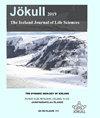Mid-crustal storage and crystallization of Eyjafjallajökull ankaramites, South Iceland
IF 0.3
4区 地球科学
Q4 GEOSCIENCES, MULTIDISCIPLINARY
引用次数: 5
Abstract
Our understanding of the long-term intrusive and eruptive behaviour of volcanic systems is hampered by a relatively short period of direct observation. To probe the conditions of crustal magma storage below South Iceland, we have analysed compositions of minerals, mineral zoning patterns, and melt inclusions from two Eyjafjallajökull ankaramites located at Brattaskjól and Hvammsmúli. These two units are rich in compositionally diverse macrocrysts, including the most magnesian olivine (Fo88−90) and clinopyroxene (Mg#cpx 89.8) known from Eyjafjallajökull. Olivine-hosted spinel inclusions have high Cr#spl (52–80) and TiO2 (1–3 wt%) and low Al2O3 (8–22 wt%) compared to typical Icelandic chromian spinel. The spinel-olivine oxybarometer implies a moderate oxygen fugacity of ∆logFMQ 0–0.5 at the time of crystallization, and clinopyroxene-liquid thermobarometry crystallization at mid-crustal pressures (1.7–4.2 kbar, 3.0±1.4 kbar on average) at 1120– 1195◦C. Liquid-only thermometry for melt inclusions with Mg#melt 56.1–68.5 and olivine-liquid thermometry for olivine macrocrysts with Fo80.7−88.9 yield crystallization temperatures of 1155–1222◦C and 1136–1213◦C, respectively. Diffusion modelling of compositional zonations in the Brattaskjól olivine grains imply that the Brattaskjól macrocrysts were mobilized and transported to the surface from their mid-crustal storage within a few weeks (at most in 9–37 days). Trends in clinopyroxene macrocryst compositions and the scarcity of plagioclase indicate that the mid-crustal cotectic assemblage was olivine and clinopyroxene, with plagioclase joining the fractionating mineral assemblage later. In all, the crystal cargoes in the Brattaskjól and Hvammsmúli ankaramites are composed of agitated wehrlitic or plagioclase wehrlitic crystal mushes that crystallized over a large temperature interval at mid-crustal depths.冰岛南部Eyjafjallajökull ankaramite的中地壳储存与结晶
我们对火山系统的长期侵入和喷发行为的理解受到相对较短时间的直接观测的阻碍。为了探索冰岛南部地壳岩浆储存的条件,我们分析了位于Brattaskjól和Hvammsmúli的两个Eyjafjallajökull ankaramites的矿物组成、矿物分带模式和熔融包裹体。这两个单元富含组成多样的大晶体,包括已知的最多的镁质橄榄石(Fo88−90)和斜辉石(mg# cpx 89.8)。与典型的冰岛铬铁尖晶石相比,橄榄石尖晶石包裹体具有较高的Cr#spl(52-80)和TiO2 (1-3 wt%)和较低的Al2O3 (8-22 wt%)。尖晶石-橄榄石氧气压计显示结晶时的氧逸度为∆logFMQ 0-0.5,斜辉石-液态热气压计结晶时的中地壳压力(1.7-4.2 kbar,平均3.0±1.4 kbar)为1120 - 1195◦C。Mg#熔体56.1-68.5熔体的纯液测温和Fo80.7 - 88.9橄榄石大晶体的纯液测温分别为1155-1222°C和1136-1213°C。对Brattaskjól橄榄石颗粒组成带的扩散模拟表明,Brattaskjól大晶体在几周内(最多9-37天)被动员并从地壳中部储存转移到地表。斜长石的大晶组成趋势和斜长石的稀缺性表明,中地壳共晶组合为橄榄石和斜长石,斜长石加入分选矿物组合较晚。总之,Brattaskjól和Hvammsmúli ankaramites中的晶体载物是由搅拌的微晶或斜长石微晶糊状晶体组成的,这些微晶糊状晶体在中地壳深处经过一个大的温度区间结晶。
本文章由计算机程序翻译,如有差异,请以英文原文为准。
求助全文
约1分钟内获得全文
求助全文
来源期刊

Jokull
地学-地球科学综合
自引率
22.20%
发文量
1
审稿时长
1 months
期刊介绍:
Jökull publishes research papers, notes and review articles concerning all aspects of the Earth Sciences. The
journal is primarily aimed at being an international forum
for geoscience research in Iceland. Specific areas of coverage include glaciology, glacial geology, physical geography,
general geology, petrology, volcanology, geothermal research, geophysics, meteorology, hydrology and oceanography. Jökull also publishes research notes and reports from
glacier expeditions, book reviews, and material of interest to
the members of the Icelandic Glaciological and Geological
Societies
 求助内容:
求助内容: 应助结果提醒方式:
应助结果提醒方式:


